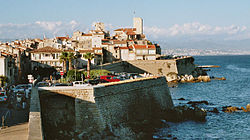| Provence-Alpes-Côte d'Azur | |
 | |
Location  | |
Coat of arms and flag  | |
| State | France |
|---|---|
| Capital | Marseille |
| Surface | 31,400 km² |
| Inhabitants | 4.818.000 (year) |
| Tourism site | |
| Institutional website | |
Provence-Alpes-Côte d'Azur (Provence-Alpes-Côte d'Azur) is one of the regions of the France.
To know
Completely included in the region is the Côte d'Azur, which part of the locality of Cassis, ending at the Italian border, one of the places in France most frequented by national and foreign tourists.
Geographical notes
It borders to the east with theItaly (Piedmont is Liguria), from which it is separated by the Alps. Inside, 10 km from the border with theItaly, encloses the small Principality of Monaco. To the north it borders the Rhône-Alpes, to the west with the Languedoc-Roussillon from which it is separated by the Rhone, while to the south it is washed by the Mediterranean Sea.
Background
Already colonized by the Greeks, the region was part of the transalpine Roman province called "Provincia Romana", from where its current name derives, from the Latin "Provincia" and, later, Narbonnaise. The region was then inhabited by different Germanic tribes, such as the Ostrogoths, Burgundians and Franks. In the year 879 AD, the region was incorporated into the kingdom under the name of Provence and then, in the 10th century, integrated into the kingdom of Arles. At the dawn of the twelfth century, it was subjected to the jurisdiction of the counts of Barcelona under the reign of Peter II of Aragon. Then, it lost all autonomy, remaining subject to the house of Anjou which ruled from 1245 to 1482 until the reign of Louis XI of France and was definitively annexed in 1483. 1720-1722: the Great Plague, which left Marseille, invaded Provence and it devastated it up to the Papal States.
Territories and tourist destinations

Urban centers
- Marseille - Capital of the region and second largest city in France by number of inhabitants.
- Aix-en-Provence - City of art and university. Homeland and eternal rest of Paul Cézanne.
- Antibes
- Arles - Source of inspiration for Vincent van Gogh. It houses numerous Roman remains.
- Avignon - Known for the palace of the popes where many popes and antipopes lived between the 14th and 15th centuries.
- Cannes - It offers a home to the wealthy and entertainers, as well as hosting the annual film festival.
- Cassis
- Gordes
- Grasse
- Istres
- La Seyne-sur-Mer
- Menton
- Montfavet
- Nice - Major seaside resort on the French Riviera and access point for theItaly.
- Orange
- Saint Tropez - Important seaside resort.
- Toulon - Medium-sized city with a historic center.
Other destinations
- French Riviera
- Gorges du Verdon - Nicknamed Grand Canyon of Europe.
- Monk
- Provence
How to get
How to get around
What see
What to do
At the table
Safety
Other projects
 Wikipedia contains an entry concerning Provence-Alpes-Côte d'Azur
Wikipedia contains an entry concerning Provence-Alpes-Côte d'Azur Commons contains images or other files on Provence-Alpes-Côte d'Azur
Commons contains images or other files on Provence-Alpes-Côte d'Azur
